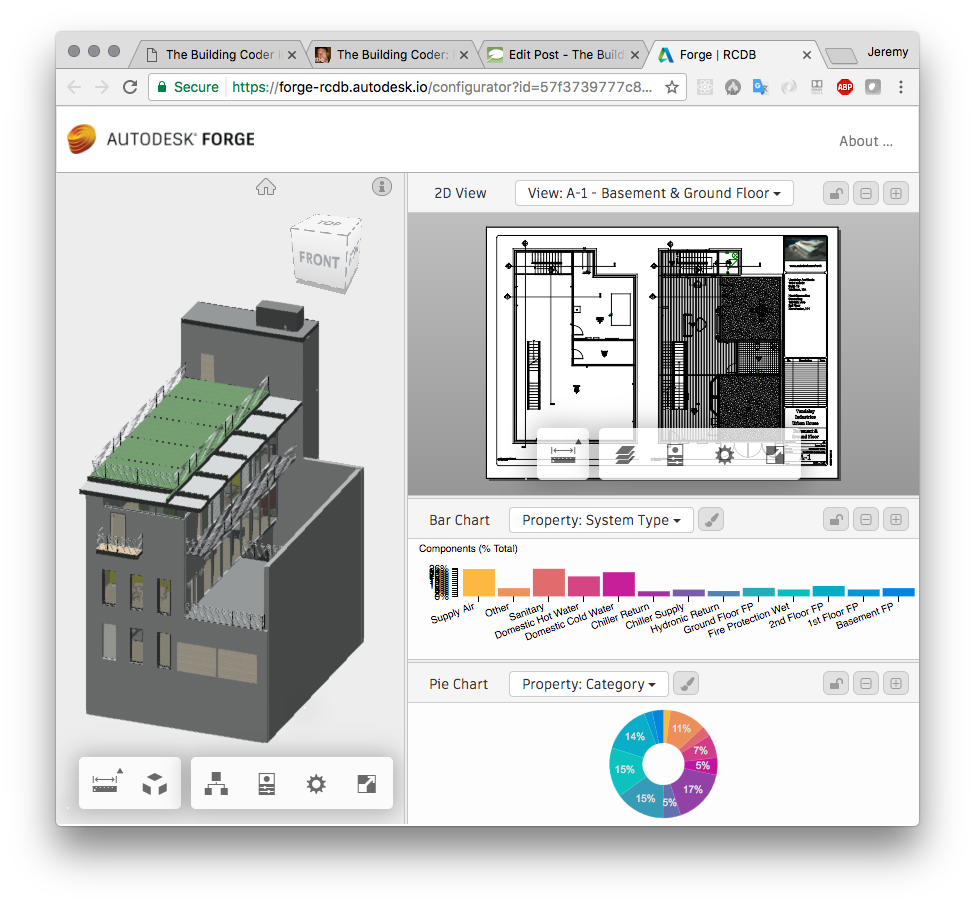Forgify
I am officially taking time off right now, but still jumping in here and there anyway, e.g. in an urgent case to reduce the RVT model file size before passing it into the Forge translator:
RvtForgify
I implemented a pretty radical and simple approach to prepare a complex RVT model for Forge translation: delete absolutely all views except the default "{3D}" one.
File size went down significantly, from 155 MB to 88 MB, i.e., 57 percent.
I am still waiting for customer feedback on the final results.
Also, more analysis is required on what elements this operation actually removes, and whether there is possibly much more stuff that could also be eliminated.
The code is super simple:
[Transaction( TransactionMode.Manual )] public class CmdDeleteViews : IExternalCommand { /// <summary> /// Delete all views except "{3D}". /// </summary> void DeleteViews( Document doc ) { IEnumerable<View> views = new FilteredElementCollector( doc ) .OfClass( typeof( View ) ) .Cast<View>() .Where<View>( v => v.CanBePrinted && !v.IsTemplate && !"{3D}".Equals( v.ViewName ) ); ICollection<ElementId> ids = views .Select<View, ElementId>( v => v.Id ) .ToList<ElementId>(); doc.Delete( ids ); } public Result Execute( ExternalCommandData commandData, ref string message, ElementSet elements ) { UIApplication uiapp = commandData.Application; UIDocument uidoc = uiapp.ActiveUIDocument; Document doc = uidoc.Document; using( Transaction tx = new Transaction( doc ) ) { tx.Start( "Delete Views" ); DeleteViews( doc ); tx.Commit(); } return Result.Succeeded; } }
The entire Visual Studio solution is provided in the RvtForgify GitHub repository.
Talking about Forge, here are frequently asked questions and answers on some basic aspects:
Forge Read-Write
Question: Is it possible to write from Forge or only read information? Let’s imagine that I would like to write properties into a file.
Answer: Right and wrong – right, because while you can do anything you like in the viewer; however, you cannot save anything back to the Forge bubble.
However, you can decide to save into your own external database, and, since unique IDs are preserved, you can integrate that data into your seed CAD file, retranslate, and reload the saved data next time. Several samples on GitHub demonstrate doing that, e.g.:
Forge in an Enterprise Service Bus
I am evaluating the use of the BIM 360 products and Forge.
I would like to connect all my AEC data regarding construction, cost estimation, etc., through an Enterprise Service Bus (ESB).
Question 1: How can Forge connect with an ESB? Any further examples besides Forge-RCDB?
Answer 1: The rcdb sample is mainly a front-end website, so not applicable to an ESB principle unless you implement a socket.io protocol. However, the sample also has a server, which could be integrated with an ESB. You would need to write the adapter for it.
Question 2: How could Forge connect with Event Driven Architecture (EDA)?
Answer 2: Like all our samples, using a node.js npm module for the server, or socket.io for the client side.
Question 3: Other examples of integration of Forge and graphics, such as charts, pie-charts, etc.?
Answer 3: You can look at our visual-report sample, and better still at this WIP sample of a basic routing table:
Here are two examples of implemented routes:
Question 4: Assuming we have a model from designers, and the programmers create an app like LMV Nav Test and set references between the 3D model, 2D drawings and report graphics like charts, and pie-charts. What happens when the original seed CAD model is slightly modified? Will the programmers need to manually recreate references between the objects for the app to work correctly? Or can they create them using rules from the model to keep track and maintain references between objects?
Answer 4: You can implement it any way you want. If you want to automate things and apply rules, you can. Forge is very basic and very flexible.
Programmers can also add custom data to the model, for example, in Inventor using iProperties, which will also be available in Forge and can be used by custom logic to automate mappings between components, graphics and so on.
The viewer DbId's can change if the original model is modified; however, for Revit projects, 2D and 3D view dbId's will stay in sync, so selecting a component in 2D can be automatically mapped to the corresponding element in the 3D view and vice-versa.
